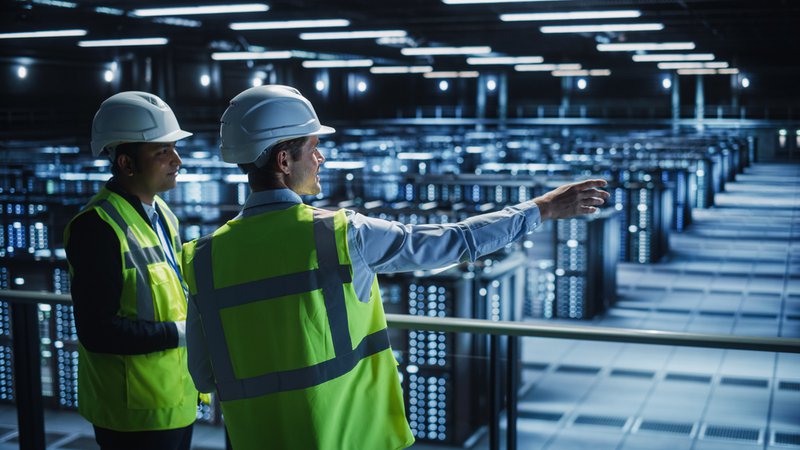The heat is on for data centers to boost their efficiency and sustainability. Never before have we seen such demand for green, low-cost, high-density facilities. In fact, a perfect storm of growing digital activity, climate awareness, and budget pressures will force organizations to adopt data center optimization strategies.
These strategies apply energy-saving tactics and technology to minimize an IT facility’s footprint. For instance, newer IT equipment and cooling systems like liquid immersion solutions increase the efficiency and sustainability of data centers.
The data center optimization strategies that we’ll discuss can help overcome the problems of outdated technology. Older platforms may have sufficed for previous generations, but we’ve reached a tipping point where higher energy efficiency is necessary. Traditional data centers simply place too much of a drain on resources to sustain their performance.

The Problem with Outdated Data Centers
As data centers age, they gradually fall behind the times. The same happens in other industries. Equipment goes stale, and new solutions come online that put the outdated facilities at a disadvantage.
Let’s explore some of the problems of outdated data centers:
Energy Waste
Many of the problems with older data centers involve energy waste. When it comes to cooling solutions in particular, previous air cooling technologies are nowhere near as efficient as new liquid immersion cooling systems. As a result, older data centers using traditional cooling methods, such as air cooling, struggle to perform efficiently enough for today’s needs.
Server Density
The poor energy efficiency of air cooling puts a cap on server density. Those old systems can only cool racks up to around 30 kilowatts (kW), but new chips reach much more than that.
Performance-limited traditional data centers can’t compete with new liquid-cooled facilities for popular services like artificial intelligence (AI) and machine learning, blockchain and cryptocurrency, or the Internet of Things (IoT).
Scalability
Another restriction on conventional air-cooled data centers is scalability. To add capacity, you have to install more servers and air cooling units, which are already slow and expensive. But then, you also need backup generators and uninterruptible power supplies (UPSs), floor space, and so forth. Rigid older data centers aren’t adaptable enough to respond quickly to changing market conditions. And all that infrastructure costs money.

Data Center Optimization Best Practices and Strategies
Every part of an IT facility contributes to its performance, so data center optimization strategies encompass different areas. You can focus on improving hardware and software, cooling and lighting, power and networking, and management systems. Let’s review a few strategies that will help.
Hardware and Software Improvements
Obviously, low-power processors will reduce your energy consumption. But there are two processor trends working at cross-purposes. Chips are growing more power-hungry even as they strive for efficiency. So, owners and operators have to balance the need for more computation against energy-saving measures.
By contrast, storage devices have a more direct incentive to use low-power solid-state drives (SSDs). In addition to conserving electricity, the SSDs run faster, quieter, and with more durability than hard disks. Some tension remains, since conventional disk drives cost less and store more data. But, companies intent on data center optimization will often prefer the power efficiency of SSDs.
Liquid Immersion Cooling
The principal system in any data center, aside from the IT equipment, is the cooling system. In some cases, an outdated air cooling system uses more energy than the computing hardware itself. So, data center optimization strategies should center themselves on more efficient cooling.
Of the various cooling technologies on the market, liquid immersion cooling boasts the highest performance. For both sustainability and profitability, it makes sense to deploy immersion cooling like GRC’s micro-modular racks. This practice reduces electrical requirements, infrastructure, IT maintenance, and IT replacement costs. It also cuts water and electronic waste and emissions.
Complementary to efficient cooling, renewable resources aid in data center optimization. Companies can install green energy systems on-site or contract with a utility to provide clean energy. You can even sell on-site solar back to the grid to generate additional revenue.
Data Center Management
Data center management systems help monitor and organize the various components of a facility. A common approach is to use data center infrastructure management (DCIM) software. This gives admins oversight of building and IT assets with sensor data. The tool helps control floor space, equipment, and energy use—all critical areas for data center optimization.
DCIM also improves uptime and capacity management. The same benefits arise from liquid immersion cooling, which simplifies planning and keeps servers running on little electricity input.
For instance, to give data center managers consolidated access to all their immersion-cooled racks, the GRC Systems Manager reports on operations. Email or text message alerts keep you on top of conditions to ensure an efficient and resilient performance. This information helps prevent downtime through proactive repairs.
Data Center Optimization for the Future
Future-proofing your data center protects it against the coming risks. It’s about saving money and the environment while also keeping server availability high. Fortunately, the same data center optimization techniques that contribute to efficiency and sustainability also support reliability.
For example, liquid immersion cooling offers practically unlimited cooling. It absorbs server heat effortlessly, unlike older systems that struggle to stay cool. Regardless of whether new high-power processors come along or your organization adds high-density racks, liquid immersion cooling will just keep working.
Given the inevitable challenges that data centers confront over time, the owners and operators who take smart steps now will prevent decline later. Each hour of downtime can tally millions of lost dollars plus intangible costs. It’s worth the effort to sidestep these common sources of failure:
- Servers overheating.
- Problems with the power or water supply bringing down a data center.
- Ambient conditions such as humidity extremes or dust particles threatening stability.
During the data center optimization process, be sure to take precautionary measures against these risks.
Optimize Your Data Center With GRC
Data center optimization opens doors to higher performance, cost savings, environmental protection, security, and scalability. Energy-efficient facilities simply do more for less.
An upgraded infrastructure provides a range of benefits. For one thing, you’ll see bigger financial returns on faster computation. The systems also become easier to scale and are more secure. Plus, the advantages accrue not only to you as the operator but also to the environment. Optimized data centers use fewer resources.
Businesses and government institutions alike use GRC’s immersion cooling systems for data center optimization, striding toward their objectives more efficiently than any other technique allows. This industry-leading cooling technology improves your bottom line and minimizes carbon emissions. It also strikingly increases the amount of kilowatts you can run per rack.
Learn more about how we can help you get the most out of your data center. Contact us today!




